Carl Gustaf recoilless rifle
The Carl Gustaf recoilless rifle (Swedish pronunciation: [kɑːɭ ˈɡɵ̂sːtav]) is an 84-mm man-portable reusable anti-tank weapon produced by Saab Bofors Dynamics (formerly Bofors Anti-Armour AB) in Sweden. Introduced in 1946, it was one of the many recoilless rifle designs of that era. While similar weapons have generally disappeared from service, the Carl Gustaf is still being made and remains in widespread use today. The Carl Gustaf is a lightweight, low-cost weapon that uses a wide range of ammunition, which makes it extremely flexible and suitable for a wide variety of roles.
| Carl Gustaf Recoilless Rifle | |
|---|---|
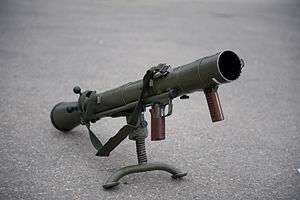 A Carl Gustaf recoilless rifle of the Norwegian Army, on display in September 2010. | |
| Type | Recoilless rifle |
| Place of origin | Sweden |
| Service history | |
| In service | 1948–present |
| Used by | See Users |
| Wars | Falklands War Lebanese Civil War Gulf War Kargil War War in Afghanistan Iraq War Eelam War IV Libyan Civil War Syrian Civil War[1] 2013 Lahad Datu standoff Iraqi Civil War (2014–2017) |
| Production history | |
| Designer | Hugo Abramson, Sigfrid Akselson and Harald Jentzen |
| Designed | |
| Manufacturer | Saab Bofors Dynamics (formerly Bofors Anti-Armour AB), Howa (license)[4][5] |
| Unit cost |
|
| Specifications | |
| Mass | (M2) 14.2 kg (31 lb)[7] (M4) 6.6 Kg |
| Length | (M2) 1,130 mm (44 in)[8] (M4) 950 mm (37 in) |
| Crew | Two (gunner and loader), but may be used by a single operator at a reduced rate of fire. |
| Cartridge | 84×246 mm R |
| Caliber | 84 mm (3.31 inches) |
| Rate of fire | 6 rounds per minute |
| Muzzle velocity | 230–255 m/s (750–840 ft/s) |
| Effective firing range | |
| Feed system | Hinged breech |
| Sights | Open (iron) sights; optical 3× laser rangefinder; image intensification system |
The weapon's name is frequently shortened. In Sweden, it is officially called the Grg m/48 (Granatgevär – "grenade rifle", model 1948). British troops refer to it as the "Charlie G", while Canadian troops often refer to it as "Carl G". In U.S. military service, it is officially known as the "M3 Multi-Role Anti-Armor Anti-Personnel Weapon System" (MAAWS) or "Ranger Anti-tank Weapons System" (RAWS), but is often just called "Gustaf". In Australia, it is irreverently known as "Charlie Gutsache" (guts ache, slang for stomach pain), or "Charlie Swede".[12]
In Estonia it is often called "Gusti" by its users.
History
The Carl Gustaf M1 was developed by Hugo Abramson and Harald Jentzen at the Kungliga Arméförvaltningens Tygavdelning ("Royal Swedish Arms Administration") and produced at Carl Gustaf Stads Gevärsfaktori from where it derives its name. The weapon was first introduced into Swedish service in 1948 as the 8,4 cm Granatgevär m/48 (Grg m/48), filling the same anti-tank role as the U.S. Army's bazooka, British PIAT and German Panzerschreck. Unlike these weapons, however, the Gustaf used a rifled barrel for spin-stabilizing its rounds, as opposed to fins used by the other systems.
The use of the recoilless firing system allowed the Gustaf to use ammunition containing considerably more propellant, firing its rounds at 290 m/s (950 ft/s), as opposed to about 105 m/s (340 ft/s) for the Panzerschreck and Bazooka and about 75 m/s (250 ft/s) for the PIAT. The result was superior accuracy at longer ranges. The Gustaf can be used to attack larger stationary targets at up to 700 m (2,300 ft), but the relatively low speed of the projectile restricts attacks on moving targets to a range of 400 m (1,300 ft) or less.
The Gustaf was soon sold around the world and became one of the primary squad-level anti-tank weapons for many West European armies. An improved, lighter and slightly shorter version, the Carl Gustaf M2, was introduced in 1964 and quickly replaced the original version. The current Carl Gustaf M3 version was introduced in 1991. It reduced the weight even further by replacing the forged steel tube with a thin steel liner containing the rifling, strengthened by a carbon fiber outer sleeve. The external steel parts were also replaced with plastics and aluminium alloys.

[In recent years, the M3 has found new life in a variety of roles. The British Special Air Service, United States Army Special Forces and United States Army Rangers use M3s in bunker-busting and anti-vehicle roles, while the German Bundeswehr maintains a small number of M2s for battlefield illumination. Many armies continue to use it as a viable anti-armor weapon, especially against 1950s- and 1960s-era tanks and other armored vehicles still in use worldwide.
In November 2011, the U.S. Army began ordering the M3 MAAWS for regular units deployed in Afghanistan. Soldiers were being engaged with RPGs at 900 meters, while their light weapons had effective ranges of 500–600 meters. The Gustaf allows airburst capability of troops in defilade out to 1,250 meters, and high explosive use out to 1,300 meters. While the weapon provides enhanced effectiveness, its 9.5 kg (21 lb) weight burdens troops. On 28 March 2013, USSOCOM announced a call for sources to develop a kit to lighten the M3 MAAWS and reduce overall length without affecting handling or ruggedness. By that time, Saab was developing a weight-reduced version prior to the SOCOM release that demonstrated no decrease in performance, no increase in recoil, and nearly equivalent barrel life that could be ready for government testing in 2014. Saab has also developed a new high explosive round that has a direct fire range of 1,500 meters when using a fire control system.[13]
M4
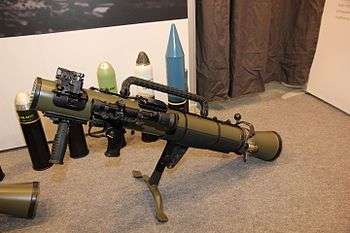

At AUSA 2014, Saab Dynamics displayed its new Carl Gustaf M4 variant. Compared to the M3 MAAWS, the M4 is 3.4 kg (7.5 lb) lighter, weighing 6.6 kg (15 lb), and shorter with a 950 mm (37 in) overall length. The shorter length was in response to the need to wield the weapon in urban terrain, and weight savings were achieved through using lighter components whenever possible including a carbon fiber tube with titanium liner, as well as a new venturi design. Other new features include a red-dot sight, a travel safety catch to allow the M4 to be carried while loaded, an adjustable shoulder rest and forward grip for improved ergonomics, a shot counter to keep track of how many rounds have been fired to manage the weapon's 1,000-round barrel life, picatinny rails for grips and sight mounts, and a remote round management function so intelligent sights can "talk" to programmable rounds.[14][15]
The US Defense Department agreed to evaluate the shorter and lighter M4 version over the next two years;[16] testing and qualifications were planned to be completed in spring 2017, and the weapon type classified as the M3E1 in fall 2017, making the system available for procurement to all Department of Defense services.[17] The first unit is planned to be equipped with the M3E1 in 2018.[18]
In April 2019, a contract of SEK168 million (USD18.1 million) was approved to supply the Australian Army with ammunition for the Carl-Gustaf M4 84 mm multipurpose weapon systems ordered by the service in September 2018.[19] In may 2020 Saab has received orders from Latvian Armed Forces and Estonian Armed Forces for deliveries of Carl-Gustaf® M4. Deliveries will take place in 2021-2024.
The orders are placed within a framework agreement signed by the Swedish Defence Materiel Administration (FMV) in June 2019, which allows Sweden, Latvia and Estonia to place orders for Carl-Gustaf M4 weapon systems during a ten-year period.
Description
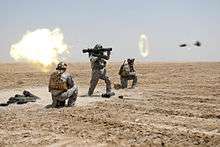
The basic weapon consists of the main tube with the breech-mounted Venturi recoil damper, with two grips near the front and a shoulder mount. The weapon is fitted with iron sights, but is normally aimed with the attached 3× optical sight with a 17 degree (300 mil) field of view. The most modern variants fielded by Swedish rifle companies have been fitted with the Swedish Aimpoint sighting system. Luminous front and rear sight inserts are available for the iron sights when aiming at night, and an image intensification system may also be used.
The Gustaf can be fired from the standing, kneeling, sitting or prone positions, and a bipod may be attached in front of the shoulder piece. An operating handle called the "Venturi lock" is used to move the hinged breech to one side for reloading. The weapon is normally operated by a two-man crew, one carrying and firing the weapon, the other carrying ammunition and reloading.
Specifications
- Calibre: 84 mm rifled (24 lands, progressive twist)[20]
- Crew: 2 optimal, 1 minimal
- Weight:
- Length:
- Effective firing range
- Breech: Hinged
- Rate of fire: 6 rounds per minute
- Sights: Iron sights, optical 3×, laser rangefinder, image intensification system
- Service life:
Ammunition

Improvements to the ammunition have been continual. While the older HEAT rounds are not particularly effective against modern tank armor, the weapon has found new life as a bunker-buster with an HEDP round. In addition, improved HEAT, high explosive (HE), smoke and illumination (star shell or flare) ammunition is also available. For full effectiveness, illumination rounds have to be fired at a very high angle, creating a danger for the gunner as the backblast from firing can burn him. For this reason, several armies have retired the illumination rounds, while the U.S. Army requires that they be fired from a standing position.
Note that the following are Swedish designations (other countries use similar terminology, replacing the "FFV - Försvarets Fabriksverk")
- FFV401 is an Area Defence Munition designed as a close-range anti-personnel round. It fires 1100 flechettes over a wide area.[33]
- FFV441 is an HE round, useful in a "lobbed" trajectory to 1,000m, which can be fused to either detonate on impact or as an airburst.
- FFV441B is an HE round with an effective range against personnel in the open of 1,100 m. The round arms after 20 to 70 m of flight, weighs 3.1 kg, and is fired at a muzzle velocity of 255 m/s.[20]
- FFV469 is a smoke round fired like the FFV441, with a range of about 1,300 m. The 3.1 kg round is also fired at 255 m/s.[20]
- FFV502 is an HEDP round with the ability to be set to detonate on either impact or one-tenth of a second afterwards. Effective range is 1,000 m against dispersed soft targets such as infantry in the open, 500 m against stationary targets and 300 m against moving targets. Minimum range is 15 to 40 m to arm the warhead. Penetration exceeds 150 mm of rolled homogeneous armour (RHA). Ammunition weight is 3.3 kg and muzzle velocity is 230 m/s.[20]
- FFV509 is an ASM (Anti-Structure Munition), designed especially for destroying buildings and other types of urban constructions. The fuse has two modes, impact or a delayed function.[34]
- FFV545 is an illuminating star shell, fired up to 2,300 m maximum range, but with an effective envelope of 300 to 2,100 m. Suspended by parachute, the star shell burns for 30 seconds while producing 650,000 candela, providing a 400 to 500 m diameter area of illumination.
- FFV551 is the primary HEAT round and is a rocket-assisted projectile (RAP). Effective range is up to 700 m (400 m against moving targets) and penetration up to 400 mm of RHA. Ammunition weight is 3.2 kg and muzzle velocity is 255 m/s.[20]
- FFV552 is a practice round with the same ballistics as the 551.
- FFV651 is a newer HEAT round using mid-flight rocket assistance for ranges up to 1,000m. In theory, it has less penetration than the FFV551, but it includes a stand-off probe for the fuse to improve performance against reactive armour.
- HEAT 655 CS (Confined Spaces) "high-explosive anti-tank (HEAT) round that can be fired by the 84 mm Carl Gustaf recoilless weapon from within small enclosures."[35][34]
- FFV751 is a tandem-warhead HEAT round with an effective range of 500 m and ability to penetrate more than 500 mm of armour. Weight is 4 kg.[20]
- FFV756 is an MT (Multi Target) ammunition, designed for combat in built-up areas and for incapacitating an enemy under cover inside a building or some type of fortification. The MT 756 uses a tandem charge.[34]
- Guided Carl Gustaf Munition (GCGM) is a laser guided projectile developed between Saab and Raytheon, featuring a multi-target warhead capable of defeating bunkers and moving light armored vehicles at a range of 2,000 m and capable of being fired from enclosed spaces; demonstrations planned for 2020.[36][37]
M3 MAAWS
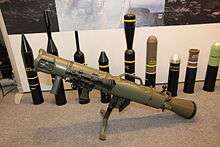
The M3 Multi-role Anti-armor Anti-tank Weapon System (MAAWS) is the U.S. military designation for the Carl Gustaf M3 recoilless rifle. It is primarily used by United States Special Operations Command such as the Army Rangers, Army Special Forces, Marine Raiders, Navy SEALs, and JSOC operators. When used by the U.S. Army's 75th Ranger Regiment, the M3 is known as the Ranger Anti-tank Weapons System (RAWS).
In the late 1980s, the Special Operations Forces Modernization Action Plan indicated need for a Ranger Anti-Armor/Anti-Personnel Weapon System (RAAWS) to replace the M67 recoilless rifle in use by the 75th Ranger Regiment. A market survey in 1987 indicated that the Carl Gustaf M3 was the best candidate for satisfying RAAWS requirements. On 29 September 1988, the M3 was selected as the RAAWS from candidate proposals submitted in response to the market survey compiled by ARDEC. A subsequent review of the contractor-supplied fatigue test data determined that the data did not meet U.S. Army requirements. Benét Laboratories conducted fatigue test of two tubes to establish an interim safe service life for the weapon. Tests were conducted in 1993. The manufacturer’s recommended life for the weapon was 500 rounds, but bore surfaces showed no indications of erosion until 2,360 rounds. The U.S. Navy SEALs became interested in the program and moved it to a Joint Integrated Product Team. The program name subsequently changed from the RAAWS to the Multi-Role Anti-Armor Anti-Personnel Weapon System (MAAWS).[38]
Army Rangers found the M3 was best employed using a two-man team. One person would carry the launcher and be armed with a pistol for personal protection, and the other would carry 5–6 rounds of ammunition and act as a spotter for the gunner. Although the single-shot AT-4 is lighter and can be carried by one person, a Gustaf team with the heavier recoilless rifle can reload and fire more rounds.[39]
The M3 MAAWS fires the following ammunition:
- High Explosive Dual Purpose (HEDP) round
- High Explosive Anti-Tank (HEAT) round
- High Explosive (HE) round
- Illumination round
- Smoke round
- High Explosive Anti-Tank - Rocket Assisted Projectile (HEAT-RAP/551)
In late 2012, the Army fielded 58 M3s and 1,500 rounds of ammunition to units deployed to Afghanistan to destroy enemy targets out to 1,000 meters. This was because RPG and machine gun teams could attack 900 meters away, while existing weaponry such as the M141 Bunker Defeat Munition, M72 LAW, M136 AT-4, and MK153 SMAW have effective ranges of only 500 meters. The AT-4 is lighter and cheaper but is made of reinforced fiberglass, while the M3's rifled metal/carbon fiber launch tube allows for reloading. Employing the 22 lb M3 is easier than the 50 lb FGM-148 Javelin with its launcher with missile and reusable command launch unit, is faster than waiting on mortars, and is cheaper than the Javelin and artillery shells for engaging targets in hard cover.[38] Although Special Operations forces had been using the M3 since the early 1990s, light infantry unit commanders in Afghanistan had to submit operational needs statements to get the weapon. The M3 became an official program of record in the conventional Army in 2014, and a conditional materiel release was authorized in late 2015 to equip all brigade combat teams with one M3 launcher per infantry platoon.[40]
M3-E1
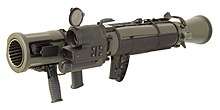
M3 was the name used for decades worldwide for the basic weapon. For the new, improved, lighter, titanium employing weapon, first displayed in 2014, the name everyone uses is: M4, except for the US. In the US the Army designation for the US version of the improved M4 mentioned above was given the name: M3-E1.
In 2017, the U.S. Army approved a requirement for 1,111 M3E1 units to be fielded to soldiers as part of an Urgent Material Release. The M3E1 is part of the Product Manager Crew Served Weapon portfolio. A key benefit of the M3E1 is that it can fire multiple types of rounds, giving soldiers increased capability on the battlefield. By using titanium, the updated M3E1, based on the M3A1 introduced in 2014, is more than six pounds lighter. The M3E1 is also 2.5 inches shorter and has an improved carrying handle, shoulder padding and an improved sighting system that can be adjusted for better comfort without sacrificing performance. The wiring harness was included in the M3E1 configuration that provides a foregrip controller and programmable fuze setter for an interchangeable fire control system. For added safety and cost savings, an automatic round counter enables Soldiers and logisticians to accurately track the service life of each weapon. The M3E1 uses the same family of ammunition as the M3, which has been successfully tested.[41]
In November 2017, the U.S. Marine Corps announced they planned to procure the M3E1 MAAWS. 1,200 M3E1s would be acquired with one fielded to every infantry squad. In addition to infantry use, the Marines are considering it to replace the Mk 153 SMAW in combat engineer squads. The weapons perform similar functions and the improvements incorporated into the new M3E1 place it in the same size and approximate weight class as the SMAW. While the SMAW weighs 2.5 lb (1.1 kg) less when loaded, the MAAWS has a greater variety of ammunition available and a maximum effective range of 1,000 meters, twice that of the SMAW. The Marines plan to test both weapons' effectiveness against bunkers to inform their decision.[42]
Risks to users
.jpg)
The overpressure or blast wave generated by the Gustaf, will cause blast and burn related injuries to those behind the weapon, and is dangerous to 30 meters[43] and hazardous to about 50 to 75 meters.[44] Repeatedly firing the Gustaf can also cause related shock wave injuries to gunners and those nearby.[45][46][47][48] As a result, during training, gunners are only allowed to fire six rounds a day.[49] The assistant gunners would also often move away from the overpressure zone, so that they too can fire six rounds a day.[50]
Comparison to similar weapons
| Weapon | Diameter | Muzzle Velocity | Warhead | Armor penetration (est.) | Effective Range | Sight |
|---|---|---|---|---|---|---|
| M2 Carl Gustaf | 84 mm | 310 m/s | 1.70 kg HEAT | 400 mm | 450 m | 2× |
| M67 recoilless rifle | 90 mm | 213 m/s | 3.06 kg HEAT | 350 mm | 400 m | 3× |
| LRAC F1 | 89 mm | 300 m/s | 2.20 kg HEAT | 400 mm | 600 m | N/A |
| RPG-7 | 93 mm | 120 m/s | 2.60 kg HEAT | 500 mm | 500 m | 2.5× |
| B-300 | 82 mm | 280 m/s | 3.00 kg HEAT | 400 mm | 400 m | N/A |
Data is from Jane's Infantry Weapons 1984–85
Users

.svg.png)

.svg.png)


.jpg) Brazilian jungle warfare soldier carrying a Carl Gustaf M3.
Brazilian jungle warfare soldier carrying a Carl Gustaf M3.

.svg.png)








.svg.png)






















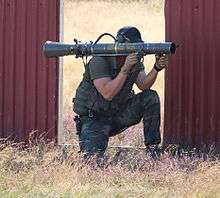

- Tamil Eelam: used by the Tamil Tigers during the Final Eelam War.[75]





Former users




See also
- NIVA XM1970, early 1970s attempt to produce a lower cost alternative to the M2 version of the Grg m/48 then in Swedish Army service
- Panzerfaust 3 (German, 1992, man-portable)
- Instalaza Alcotán-100 (Spain, 100 mm, man-portable)
- Instalaza C-90 (Spain, 90 mm, man-portable)
- AT4, a Swedish one-shot recoilless-rifle assault weapon
- SMAW, an American 83 mm rocket assault weapon
- M72 LAW, an American 66 mm light anti-tank weapon
- RPG-2 (USSR, 1947, man-portable)
- 55 S 55 (Finland, 1947, 55 mm, man-portable)
- M40 recoilless rifle (USA, 1947, 106 mm, tripod mounted)
- B-10 recoilless rifle (USSR, 1954, 82 mm, tripod mounted)
- M67 recoilless rifle (USA, 1960s, 90 mm, man-portable)
References
- "YouTube". www.youtube.com. Archived from the original on 19 November 2017. Retrieved 29 October 2017.
- Carl Gustaf M4, Saab, 2014, archived from the original on 2014-09-30
- Saab's latest Carl Gustaf M4 system impresses customers in live fire demonstration (press release), Saab, 2014-09-26, archived from the original on 30 September 2014, retrieved 26 September 2014,
The official Carl Gustaf M4 product launch will take place at the AUSA exhibition in Washington, DC, on 13–15 Oct 2014
- "84mm無反動砲「カール・グスタフ」", Right-Wing (in Japanese), JP: Sakura, retrieved 2009-11-04
- Exhibition of Equipments, JP: Plala, archived from the original on March 13, 2012, retrieved July 29, 2008.
- "Archived copy". Archived from the original on 2018-12-24. Retrieved 2018-12-23.CS1 maint: archived copy as title (link)
- http://www.sadefensejournal.com/wp/?p=3977 Archived 2019-01-08 at the Wayback Machine Small Arms Defense Journal. THE NEW CARL-GUSTAF M4: LIGHTER–BETTER–SMARTER. 2 June, 2017
- http://www.sadefensejournal.com/wp/?p=3977 Archived 2019-01-08 at the Wayback Machine Small Arms Defense Journal. THE NEW CARL-GUSTAF M4: LIGHTER–BETTER–SMARTER. 2 June, 2017
- User Handbook for the Gun, 84mm, INF, ATK, L14A1, Director of Army Equipment Policy. 1968. page 2
- User Handbook for the Gun, 84mm, INF, ATK, L14A1, Director of Army Equipment Policy. 1968. page 2
- User Handbook for the Gun, 84mm, INF, ATK, L14A1, Director of Army Equipment Policy. 1968. page 2
- "The Encyclopedia of Middle East Wars", p. 259
- "SOCOM Seeks Lighter Carl Gustaf". Defense media network. 22 April 2013. Archived from the original on 24 April 2013. Retrieved 27 June 2013..
- New Carl-Gustaf weapon system design unveiled Archived 2014-10-24 at the Wayback Machine – Military1.com, 8 October 2014
- Saab Adds Capabilities In New Recoilless Rifle Archived 2014-10-23 at the Wayback Machine Aviation Week, 13 October 2014
- Army, Special Operations Forces Eye Lighter, Cheaper Shoulder-Fired Weapons Archived 2014-11-19 at Archive.today National Defense Magazine, 10 November 2014
- Army Evaluates New Shoulder-Fired Rocket Tech Archived 2016-10-23 at the Wayback Machine – Kitup.Military.com, 20 October 2016
- Army Maps Out Future Small-Arms Programs Archived 2017-05-17 at the Wayback Machine – Military.com, 9 May 2017
- "Saab awarded ammunition contract for Australian Army's Carl-Gustaf M4 weapon system | Jane's 360". www.janes.com. Archived from the original on 2019-04-12. Retrieved 2019-04-17.
- https://ia800801.us.archive.org/6/items/WorldwideEquipmentGuide1999/TRADOC%20OPFOR%20Worldwide%20Equipment%20Guide%20%5B1999%5D.pdf
- http://www.sadefensejournal.com/wp/?p=3977 Archived 2019-01-08 at the Wayback Machine Small Arms Defense Journal. THE NEW CARL-GUSTAF M4: LIGHTER–BETTER–SMARTER. 2 June, 2017
- http://www.sadefensejournal.com/wp/?p=3977 Archived 2019-01-08 at the Wayback Machine Small Arms Defense Journal. THE NEW CARL-GUSTAF M4: LIGHTER–BETTER–SMARTER. 2 June, 2017
- http://www.sadefensejournal.com/wp/?p=3977 Archived 2019-01-08 at the Wayback Machine Small Arms Defense Journal. THE NEW CARL-GUSTAF M4: LIGHTER–BETTER–SMARTER. 2 June, 2017
- http://www.sadefensejournal.com/wp/?p=3977 Archived 2019-01-08 at the Wayback Machine Small Arms Defense Journal. THE NEW CARL-GUSTAF M4: LIGHTER–BETTER–SMARTER. 2 June, 2017
- http://www.sadefensejournal.com/wp/?p=3977 Archived 2019-01-08 at the Wayback Machine Small Arms Defense Journal. THE NEW CARL-GUSTAF M4: LIGHTER–BETTER–SMARTER. 2 June, 2017
- http://www.sadefensejournal.com/wp/?p=3977 Archived 2019-01-08 at the Wayback Machine Small Arms Defense Journal. THE NEW CARL-GUSTAF M4: LIGHTER–BETTER–SMARTER. 2 June, 2017
- User Handbook for the Gun, 84mm, INF, ATK, L14A1, Director of Army Equipment Policy. 1968. page 2
- User Handbook for the Gun, 84mm, INF, ATK, L14A1, Director of Army Equipment Policy. 1968. page 2
- User Handbook for the Gun, 84mm, INF, ATK, L14A1, Director of Army Equipment Policy. 1968. page 2
- https://apps.dtic.mil/dtic/tr/fulltext/u2/a352481.pdf
- https://apps.dtic.mil/dtic/tr/fulltext/u2/a277071.pdf
- "Archived copy". Archived from the original on 2019-01-07. Retrieved 2019-01-07.CS1 maint: archived copy as title (link)
- https://www.thelocal.se/20110306/32424 Peace group slams sale of Swedish 'meat grinder' ammunition
- "THE 84 mm carl-gustaf Multi-purpose Weapon System" (PDF). Archived (PDF) from the original on 2017-03-29. Retrieved 2016-12-07.
- "Saab reveals confined spaces capability for Carl Gustaf", Infantry Weapons, Jane's, archived from the original on 2014-02-25, retrieved 2014-02-20.
- The Carl Gustaf is getting a ‘game changing’ laser-guided munition. Army Times. 9 October 2018.
- "Saab, Raytheon to Demonstrate a Guided Munition for Carl Gustaf M4 Recoilless Rifle - Defense Update:". Archived from the original on 2019-03-02.
- "Saab to Supply Carl-Gustaf 84mm Recoilless Rifle System to the U.S. Army", SA defense journal, 19 June 2013, archived from the original on 4 November 2013, retrieved 19 September 2013.
- Carl Gustaf Rules In America, Strategy page, 10 September 2014, archived from the original on 12 September 2014, retrieved 12 September 2014.
- US Army Adds 84mm Recoilless Rifle to Platoon Arsenal Archived 2016-05-23 at the Wayback Machine – Military.com, 20 May 2016
- Army to rapidly procure reusable shoulder-fired weapon system Archived 2017-09-08 at the Wayback Machine army.mil, 8 September 2017
- Marines Eye Carl Gustaf to Replace SMAW for Bunker Breaching Archived 2017-11-12 at the Wayback Machine - Military.com, 7 November 2017
- User Handbook for the Gun, 84mm, INF, ATK, L14A1, Director of Army Equipment Policy. 1968. page 2
- http://www.sadefensejournal.com/wp/?p=3977 Archived 2019-01-08 at the Wayback Machine Small Arms Defense Journal. THE NEW CARL-GUSTAF M4: LIGHTER–BETTER–SMARTER. 2 June, 2017
- "Do U.S. Troops Risk Brain Injury When They Fire Heavy Weapons?". npr.org. Archived from the original on 30 October 2017. Retrieved 29 October 2017.
- "Pentagon Shelves Blast Gauges Meant To Detect Battlefield Brain Injuries". npr.org. Archived from the original on 7 November 2017. Retrieved 29 October 2017.
- "Blast Overpressure Is Generated From The Firing Of Weapons, And May Cause Brain Injury". sciencedaily.com. Archived from the original on 24 October 2017. Retrieved 29 October 2017.
- "A swedish infantryman after a long day of firing the Carl-Gustaf". reddit. Archived from the original on 3 May 2015. Retrieved 29 October 2017.
- The Big Book of Gun Trivia: Everything you want to know, don't want to know, and don't know you need to know. By Gordon L. Rottman. Bloomsbury Publishing, Oct 20, 2013. Page 49
- The Big Book of Gun Trivia: Everything you want to know, don't want to know, and don't know you need to know. By Gordon L. Rottman. Bloomsbury Publishing, Oct 20, 2013. Page 49
- Infodefensa.com (31 August 2016). "Argentina adquiere cañones sin retroceso Carl Gustaf y un radar de vigilancia terrestre - Noticias Infodefensa América". infodefensa.com. Archived from the original on 29 October 2017. Retrieved 29 October 2017.
- "Carl Gustaf , AT-4CS y fusiles Steyr HS.50 M1 para el Ejército Argentino". zona-militar.com. 27 October 2017. Archived from the original on 29 October 2017. Retrieved 29 October 2017.
- Jones, Richard D. Infantry Weapons 2009/2010. Jane's; 35 ed. (January 27, 2009). ISBN 978-0-7106-2869-5.
- "Direct fire support weapons land 40 phase 2". Defence Material Organisation. October 2010. Archived from the original on 10 April 2011. Retrieved 24 April 2011.
- "Grenade", World, RU: Guns.
- Infodefensa.com (21 December 2018). "La II División realiza instrucción de tiro con el sistema 'Carl Gustav' - Noticias Infodefensa América". infodefensa.com. Archived from the original on 29 December 2018. Retrieved 29 December 2018.
- Karl Gustaf protitanková zbraň (in Czech), CZ: Army, archived from the original on 2016-03-04, retrieved 2015-04-20.
- "Dysekanon M/79", Panser værns våben (in Danish), DK: Dansk panser.
- "Dysekanon M/85", Panser værns våben (in Danish), DK: Dansk panser.
- 84 mm tankitõrjegranaadiheitja Carl-Gustav M2 (in Ewe), EE: Military, archived from the original on 2017-12-19, retrieved 2015-04-20.
- "Armored vehicle weapons in formation", Greek Army ground forces military equipment, Army Recognition.
- "DRDO Develops New 84mm Lightweight Anti-Tank System". India. Archived from the original on 2016-12-19. Retrieved 2016-10-01.
- "Kopassus & Kopaska – Specijalne Postrojbe Republike Indonezije" (in Croatian). HR: Hrvatski Vojnik Magazine. Archived from the original on 2010-08-22. Retrieved 2010-06-12.
- Small Arms Survey (2015). "Trade Update: After the 'Arab Spring'" (PDF). Small Arms Survey 2015: weapons and the world (PDF). Cambridge University Press. p. 110. Archived (PDF) from the original on 2018-01-28. Retrieved 2018-08-29.
- Kuwait – Army Equipment, Global security, archived from the original on 2017-07-03, retrieved 2014-07-21.
- Prieštankinis granatsvaidis AT-4 (in Lithuanian), LT: KAM, archived from the original on 2014-10-09, retrieved 2013-12-12.
- Prieštankinis granatsvaidis "Carl Gustaf" M2, M3 (in Lithuanian), LT: KAM, archived from the original on 2010-07-31, retrieved 2010-08-02.
- "Svenska vapen hos Burmas arme" [Sweden sells to Burma’s army], SvD (in Swedish), SE, archived from the original on 2012-12-12, retrieved 2012-12-11.
- Altair, PL, archived from the original on 2010-03-26.
- Exercício Capolo no distrito de Santarém [Capolo exercise in the Santarém district] (in Portuguese), PT: Operacional, archived from the original on 2011-07-25, retrieved 2010-09-19.
- "Armas", Meios dos fuzileiros [Marines’ equipment] (in Portuguese), PT: Marinha.
- Rottman, Gordon L. (1993). Armies of the Gulf War. Elite 45. Osprey Publishing. p. 30. ISBN 9781855322776.
- Launch customer for Carl-Gustaf M4 Archived 2015-09-28 at the Wayback Machine – Shephardmedia.com, 16 September 2015
- Tomkins, Richard (18 July 2017). "Slovakia deploys Saab's Carl-Gustaf M4 weapon". United Press International. Archived from the original on 18 July 2017. Retrieved 18 July 2017.
- Army, LK, archived from the original on 2011-12-17.
- The World defense almanac 1996–97, p. 32.
- Robinson, Spc Nigel (2011-10-27). "Carl Gustaf Recoilless Rifle". 7th Mobile Public Affairs Detachment. Defense Video and Imagery Distribution System. Retrieved 15 November 2011.
- "U.S. Army Orders Additional Carl-Gustaf Weapon System", Defense talk, 27 September 2012, archived from the original on 11 September 2013, retrieved 27 June 2013.
- "Carl Gustaf Selected as Standard Equipment for U.S. Army Light Infantry Units", Deagel, 20 February 2014, archived from the original on 24 February 2014, retrieved 21 February 2014.
- "US Army approves Carl Gustaf M3 MAAWS for general use", IHS Janes, 16 May 2016, archived from the original on 17 May 2016, retrieved 16 May 2016.
- Talens, Martien. De ransel op de rug deel 2. Brabantia Nostra. p. 400.
- Handboek voor de Marinier 1978 p. 21-53
- Gmelich Meijling, J. C. (1998-02-09). "Brief staatssecretaris - Anti-tankwapens". Archived from the original on 2018-02-15. Retrieved 2018-02-14.
- "Army News – Issue No. 235" (PDF). Ministry of Defence, Singapore. 2015. Archived from the original (PDF) on 2015-06-23. Retrieved 2015-06-23.
- Owen, William F. (2007). "Light Anti-Armour Weapons: Anti-Everything?" (PDF). Asian Military Review. Archived from the original (PDF) on 2011-07-07. Retrieved 2010-05-12.
- AE84-RCL recoilless rifle, AEI Systems, archived from the original on September 3, 2014, retrieved September 16, 2014.
External links
| Wikimedia Commons has media related to Carl Gustaf recoilless rifle. |
- Saabs Bofors – manufacturer's product page
- Saab Bofors – official manufacturer's brochure
- Saabs Bofors – Area Defence Munition (ADM 401) brochure
- Instructors Manual – Canadian Forces
- Video of loading and firing drill for Carl Gustaf recoilless rifle
- Video of a Carl Gustaf recoilless rifle being fired
- M3 MAAWS at GlobalSecurity.org
- Carl Gustaf anti-tank recoilless rifle (Sweden) – Modern Firearms
- U.S. Army Armament Research, Development & Engineering Center FCT and SOCOM Shoulder Fired Weapons May 2005
_soldier%2C_right%2C_participates_in_a_simulated_combined_company_attack_with_U.S._Marines_assigned_to_the_1st_Battalion%2C_1st_Marine_Regiment_at_Marine_Corps_Base_Camp_140209-M-SV584-216.jpg)